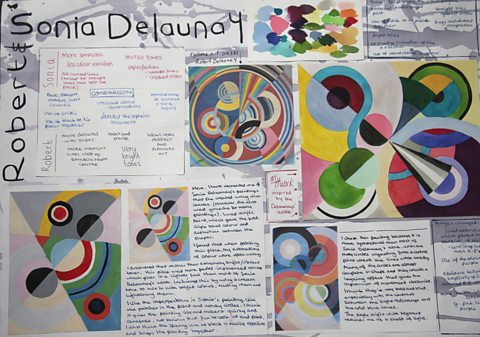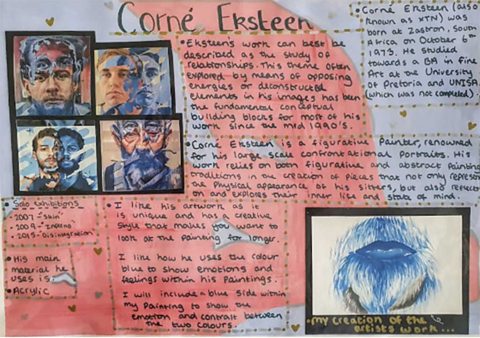Finding inspiration in the work of artists

A student takes inspiration from Robert and Sonia Delaunay. Other artists' ideas and use of elements can help you develop your own visual language

A student's research into Corné Eksteen
Studying the work of different artists should give you ideas for your own work.
Choose artists and artworks that relate to your own practical work, perhaps through similar subject matter, theme or styleA distinctive type of interpretation in art or design. For example the Cubist style can be identified by fragmented, geometric appearance and use of multiple viewpoints..
Completing a critical analysisA detailed examination of an artwork or design that give opinions, make judgements and draw conclusions. of artworks will make sure you have a good understanding of the work and can help you develop your own creativity. For each artwork:
- describe how the artist has used a range of art materials, techniques and/or technology in the work
- describe the artist's creative choices and write about how these have impacted on the work, for example:
- their use of visual elements, eg colour, shape, pattern
- their choice of composition, eg balance, emphasis, unity and variety
- the viewpointThe place or position from which the artwork was created. Examples include eye level, from an elevated position and bird's eye view. they have chosen to show their subject from
- investigate social influenceAn event which had an impact on an artwork or design. For example the bombing of a town during the Spanish Civil War inspired Picasso to paint âGuernica.â and cultural influenceA cultural event which had an impact on an artwork or design. For example, the Impressionist movement had an impact on the Post-Impressionists. and describe how these have impacted on the artwork
The spidergram below sets out different parts of an artist's work that you should consider.
Checklist
- collect images of a variety of artists' and designers' work when you begin your research. Keep an open mind.
- select artworks for analysis which are relevant to your own chosen subject matter
- choose artworks in styles that you like and which you would like to try
- choose artists that you can find reliable information on so that you can research their techniques and find out about social and cultural influences on their work
- ensure that all comments about social and cultural influences in your critical analysis relate directly to the effect on the selected artworks
More guides on this topic
- Responding to stimuli - AQA
- Analytical drawing - AQA
- Developing ideas - AQA
- Creating a design brief - AQA
- Experimenting with materials and techniques - AQA
- Recording and observing - AQA
- Annotating your work - AQA
- Analysing and evaluating - AQA
- Assessment objectives and presenting your work - AQA
- Externally set assessment - AQA